If you discover a fire or see smoke in your work area, the first thing you should do is sound the alarm.
By sounding the alarm, you put into practice a safety system which allows everyone in the workplace to make their means of escape to a predetermined place of safety.
In order to assist or enable your escape you may need to use a Portable Fire Extinguisher.
There are many types of fire extinguisher because there are many types of fire. Each extinguisher is designed to be used on a specific class of fire. It is important to know which one to use to ensure that your actions are as effective as possible.
This guide explains each type of Portable Fire Extinguisher and how to use it in case of an emergency.
Fire Classes
Fires are divided into six main types, depending on the nature of the fuel involved:

Fire Extinguisher Types
This table shows the types of Fire Extinguisher suitable for each class of fire.
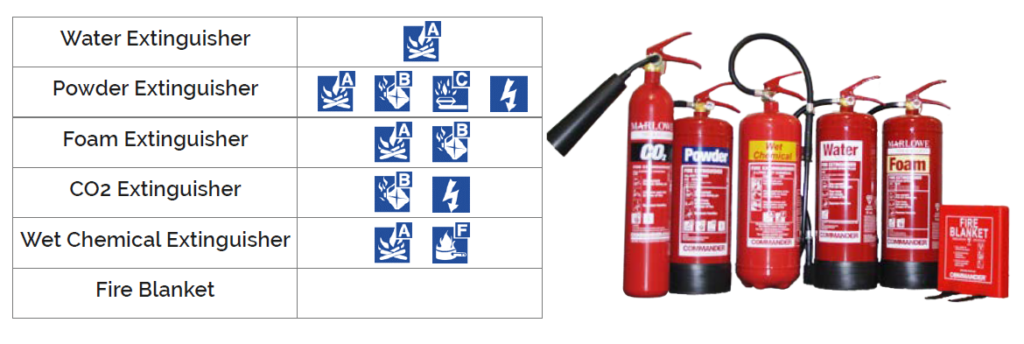
* Technically ‘Class E’ doesn’t exist. Before this classification system, there was a classification of electrical fires, but since electricity itself is a cause of fire, these types of fires have been incorporated into the main classes. Once you have turned off the electricity the fire becomes the same as any other.
Types of Portable Fire Extinguisher
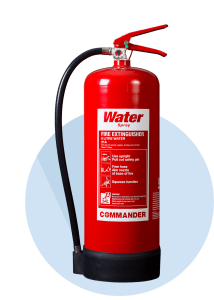
The most common extinguisher that covers freely burning materials such as Paper, Wood, Curtains.
Water extinguishers are not safe on electrical risks or flammable liquids such as cooking oils, petroleum, and petroleum products.

A multi-purpose extinguisher that covers the following types of fire:
Freely burning materials such as paper, wood, curtains, etc.
Flammable liquids such as petrol, diesel, white spirits, etc.
Flammable gases such as Butane, Propane, etc.
Electrical Risk fires
Powder is not suitable on cooking oil fires. Powder is not for use in enclosed spaces.

A dual purpose extinguisher that covers freely burning materials such as the water extinguisher does.
It also provides cover for the following flammable liquids; Petrol, Diesel, White Spirits.
Foam extinguishers are not safe to use on cooking oil.
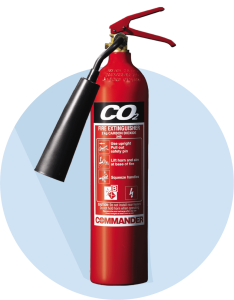
Contain pure carbon dioxide which is a clean extinguishant, leaving no residue.
Predominantly used for electrical risk fires but also suitable for class B flammable liquid fires; Petrol, Oil, Solvents.
CO2 fire extinguishers are a clean agent. They do not have the cooling effect of a foam extinguisher, meaning that if there is a fuel fire, the person operating the extinguisher may need to follow up with a foam extinguisher.

Designed for Cooking Oil fires only.
Stand at least 1 metre away from the deep fat fryer and then discharge into the deep fat fryer.
They also cover freely burning materials such as paper wood curtains.
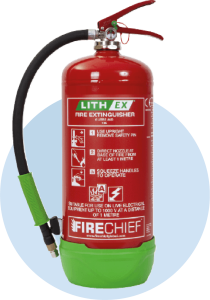
Lithium Battery Fire Extinguishers are specialist high performance extinguishers designed to stop lithium-ion battery fires fast.
Conventional fire extinguishers cannot effectively extinguish a lithium-ion battery fire. Only a specialist extinguisher such as the Firechief Lith-Ex extinguisher is suitable on this type of fire.
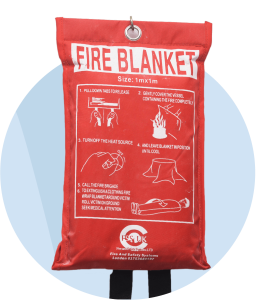
Used to smother smaller fires, cutting off the oxygen supply.
Fire blankets can cover the following:

Colour Codes
Fire extinguishers have colour codes labelling the type of extinguisher they are. These are represented on a band at the top of the extinguisher.
Their purpose is to make identification easier and faster for the user. Each extinguishing medium is assigned its own colour code.

Which Portable Fire Extinguisher to Use
Each extinguisher is designed to be used on a specific class of fire. It is important to use the right extinguisher to ensure that your actions are as effective as possible and don’t further ignite the fire.

Fire Extinguisher Servicing
Professional maintenance of fire extinguishers is a vital part of any business’ fire safety strategy, understanding that the integrity of these systems need to be maintained to protect the safety of not only your premises and assets but also your employees and residents.
Fire extinguishers must be serviced every 12 months or after each use by a BAFE SP101 certified service provider. If an extinguisher is found to be leaking, it should be serviced immediately.
We offer a total fire extinguishers supply, installation and maintenance solution at a competitive price. Contact Us for a free no obligation quotation.
How to use a Fire Extinguisher
Portable Fire Extinguishers and Fire Blankets are designed as First Aid Fire Fighting Equipment.
You should not spend more than ten seconds taking control of a fire.
Do not put yourself or others at risk and always keep your means of escape behind you when tackling a small fire.

How to use a Water Fire Extinguisher
1. Before attempting to fight a fire with a fire extinguisher it is important to check that it is fully charged (Fig. 1) and the safety pin is not bent (Fig. 2).
2. Ensure you remain a safe distance from the fire and remove the safety pin (Fig 3). This will break the tamper seal.
3. Where to aim the fire extinguisher hose:
a. Fire spreading horizontally: Aim the hose at the base of the fire, moving the jet across the area of the fire.
b. Fire spreading vertically: Aim the hose at the base of the fire. slowly moving the jet upwards following the direction of the fire.
4. Squeeze the lever slowly to begin discharging the extinguisher. As the fire starts to diminish, move closer to it.
5. Ensure all the fire has been extinguished: try to focus on any hot spots that may re-ignite.
How to use a Powder Fire Extinguisher
1. Before attempting to fight a fire with a fire extinguisher it is important to check that it is fully charged (Fig. 1) and the safety pin is not bent (Fig. 2).
2. Ensure you remain a safe distance from the fire and remove the safety pin (Fig 3). This will break the tamper seal.
3. Where to aim the fire extinguisher hose:
a. Solid Materials: Aim the hose at the base of the flames, moving across the area of the fire.
b. Spilled liquids: Aim the hose at the near edge of the fire and with a rapid sweeping motion: drive the fire towards the far edge until the flames have been extinguished.
c. Flowing liquid: Direct the hose at the base of the fire and sweep upwards until the flames have been extinguished.
d. Electrical equipment: Switch off the power (if safe to do so) and then direct the hose straight at the fire.
4. Squeeze the lever slowly to begin discharging the extinguisher. As the fire starts to diminish, carefully move closer to it.
5. Ensure all the fire has been extinguished: re-ignition can be possible when a powder fire extinguisher has been used.
How to use a Foam Fire Extinguisher
1. Before attempting to fight a fire with a fire extinguisher it is important to check that it is fully charged (Fig. 1) and the safety pin is not bent (Fig. 2).
2. Ensure you remain a safe distance from the fire and remove the safety pin. This will break the tamper seal.
3. Where to aim the fire extinguisher hose:
a. Flammable liquids: Aim the hose at a vertical surface near the fire, do not spray directly at the fire as this could cause the fire to be pushed and spread to surrounding areas.
b. Foam extinguishers allow a build up of foam across the surface of the fire causing it to be smothered.
c. Solid combustibles: Aim the hose at the base of the fire, moving across the area of the fire.
4. Squeeze the lever slowly to begin discharging the extinguisher, as the fire starts to diminish carefully move closer to it.
5. Ensure all the fire has been extinguished, the foam creates a blanket over the fire and helps to prevent re-ignitions.
How to use a CO2 Fire Extinguisher
1. Before attempting to fight a fire with a fire extinguisher it is important to check that it is fully charged (Fig. 1) and the safety pin is not bent (Fig. 2).
2. Ensure you remain a safe distance from the fire and remove the safety pin (Fig 3). This will break the tamper seal.
3. DO NOT hold the horn as it becomes extremely cold during use and can lead to severe frost burns.
4. Aiming the extinguisher:
a. Flammable liquids: Aim the horn at the base of the fire and move across the area
b. Electrical equipment: Switch off the power (if safe to do so) and then direct the hose straight at the fire
5. Squeeze the lever slowly to begin discharging the extinguisher. As the fire starts to diminish, carefully move closer to it.
6. Ensure all the fire has been extinguished as re-ignition is possible when a CO2 extinguisher has been used.
How to use a Wet Fire Chemical
1. Before attempting to fight a fire with a fire extinguisher it is important to check that it is fully charged (Fig. 1) and the safety pin is not bent (Fig. 2).
2. Turn off the heat source if it safe to do so.
3. Ensure you remain a safe distance from the fire and remove the safety pin (Fig 3). This will break the tamper seal.
4. Hold the lance at arm’s length, well above the fire with its nozzle at least 1 meter away from the fire.
5. Squeeze the lever slowly to begin discharging the extinguisher.
6. Apply the fine spray in slow circular movements. This allows the wet chemical agent to fall gently onto the surface of the fire and helps to prevent hot oils splashing on to the user.
7. Discharge the entire contents of the extinguisher to ensure that all of the fire has been extinguished: the wet chemical formula helps to prevent re-ignition.
How to use a Fire Blanket
1. Turn off the heat source if it is safe to do so (DO NOT attempt to move the pan).
2. Pull the tapes to release the blanket from its container.
3. Hold the blanket in a shield position and if possible, wrap the blanket around your hands for protection.
4. Place the blanket gently over the pan/container to smother the fire.
5. Leave the pan to cool completely – DO NOT attempt to uncover until it is completely cool.
Fire blankets can also be used on fire involving personal clothing, simply wrap the blanket tightly around the fire to smother.
Fire Extinguisher FAQs
Why are there so many types of fire extinguisher?
What chemicals are used in a fire extinguisher?
What are the different colour codes on fire extinguishers?
Are any fire extinguishers all purpose?
What type of fire can each extinguisher be used on?
What happens if you use the wrong fire extinguisher?
What happens if you’re accidentally sprayed with a fire extinguisher?
How long do fire extinguishers last?
How do you repair a fire extinguisher?
How do you refill a fire extinguisher?
